
Warts or plantar spine are one of the most unpleasant types of skin growth. Such a formation is located on the supporting part of the foot or toe. It is composed of growing epithelial cells and has deep roots that extend into the depths of the dermis.
Thorns do not pose a particular danger in terms of oncogenicity, but they can be very painful and cause discomfort when walking. Such growth is difficult to treat, and is characterized by a tendency to relapse. How to get rid of plantar warts, which method is considered the most effective and safe? Get information on this from our article.
Why do Thorns Appear?
Warts on the legs are benign neoplasms that are viral in nature. The cause of their appearance is infection with HPV (papilloma virus). Pathogens are spread from person to person by contact, or come into contact with the skin when in contact with an infected surface. It tastes great in a warm, humid environment, where it can be stored for a long time. The risk of infection is very high in public places - baths, saunas, gyms, swimming pools. The virus easily enters the body through small abrasions or scratches on the skin.
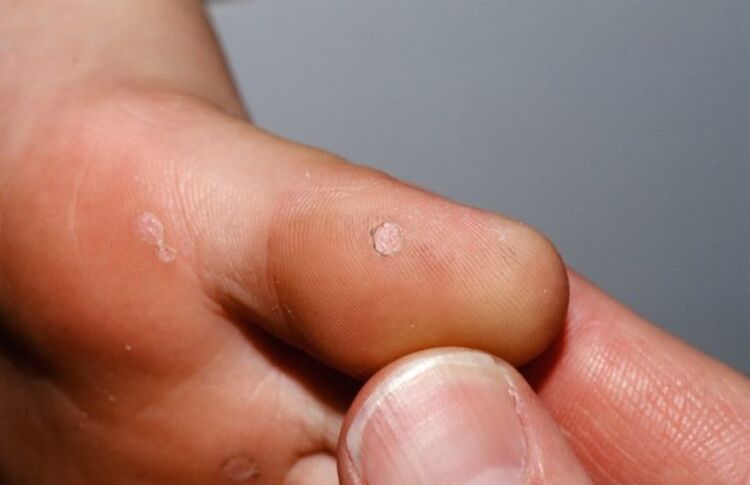
A strong immune system suppresses the replication of the virus and puts it into a latent state. But as soon as the body’s defenses weaken, pathogens are activated and begin to multiply rapidly. Illness, stress, violation of standards of personal hygiene have recently become factors that provoke the immune defense. The following factors contribute to the formation of plantar warts:
- excessive foot sweat;
- wearing tight and uncomfortable shoes;
- skin microtrauma (abrasions, scratches, wounds, abrasions);
- frequent contact with water and detergents that provoke dry skin;
- chronic diseases associated with impaired blood circulation in the lower limbs (diabetes mellitus, atherosclerosis, varicose veins);
- foot deformities (flat feet, arthritis of the small joints, osteoarthritis);
- persistent callus formation, corns.
Plantar warts can be found by wearing the shoes of an infected person or visiting a pedicure salon where the tools are poorly disinfected. Plantar warts in children often form after visiting swimming pools, summer camps, public baths, where babies may mistakenly wear other people’s shoes, walk barefoot on dirty surfaces, or use infection-carrying personal items (towels, wipes, etc. ). Parents should teach their babies to adhere to personal hygiene norms as early as possible and explain why it is impossible to use other people’s items.
What are plantar warts like?
The incubation period, during which the papilloma virus multiplies, is quite long - from 1. 5 to 4 months. First, the pathogen affects the basal layer of the epidermis, then spreads upwards, leading to the formation of special features on the skin.
Initially, warts on the feet of children or adults look like round-shaped shiny plaques and small in diameter (up to 2 cm). Immediately its surface becomes rough, covered with a dense stratum corneum, rising above the surface of the skin. The color of the spine changes from flesh to yellowish gray. A crater -shaped depression appears in the center of the neoplasm. On closer examination, black spots appear on the surface of the wart. These are thrombosed capillaries that come out to the surface. The presence of this feature allows you to distinguish plantar warts from corns or calluses. Photos of plantar warts give a complete picture of how this formation forms on the skin.
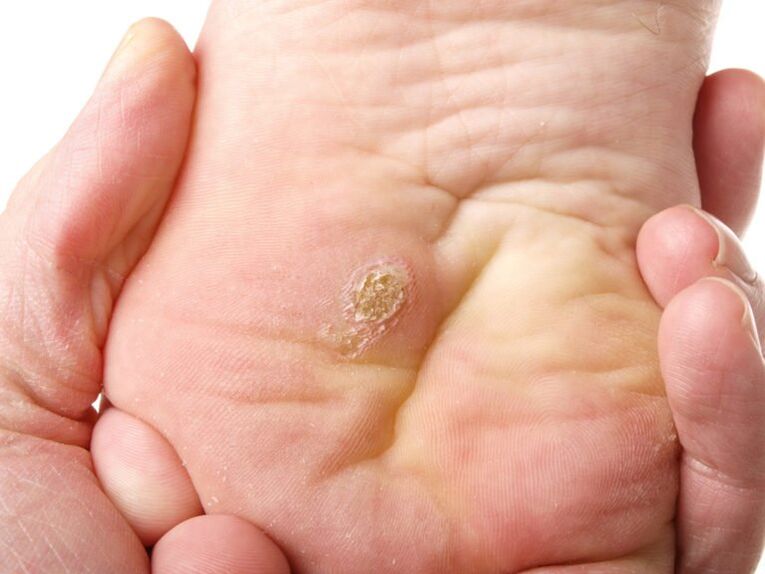
The favorite place for spinal localization is the area of the foot that experiences the greatest stress. The root of the neoplasm goes deep into the dermis, irritating the nerve endings, therefore, such warts cause a painful sensation when walking. Growth on the soles of the feet is single and multiple. Usually, maternal warts first appear on the legs. If the virus is very active, soon a daughter formation will form next to it. Sometimes the spine disappears on its own, but more often a persistent injury causes its growth and the appearance of severe pain due to constant shoe pressure.
How to get rid of warts on the legs if such a formation is painful and causes severe discomfort? First of all, you need to contact a dermatologist for examination and treatment. Plantar warts are not easy to treat because they grow deep into the dermis. To prevent the recurrence of the spine, the root of the neoplasm must be completely removed. This can be done in different ways - medication and surgery.
Plantar warts: treatment
There are several methods of dealing with plantar warts. At home, pharmaceutical products can be used to treat warts on the feet. Physicians should choose a therapeutic regimen, because a positive effect can be achieved only with the right and competent approach.
Drug therapy
For the treatment of plantar warts at home, various methods are used - from destruction by aggressive chemicals (acids, alkalis) to the coagulation of pathological tissue in a special way. To exclude recurrence, it is necessary not only to eliminate the growth, but also to suppress the activity of the virus.
This complex treatment is based on the following groups of drugs:
- Antiviral and immunomodulatory agents.Creams that activate local immunity and inhibit the reproduction of viruses have a good therapeutic effect. It must be used twice a day under a bandage. For the same purpose, creams that stimulate interferon production are used.
- Keratolytic agents.Preparations based on salicylic or trichloroacetic acid are designed to soften and exfoliate the rough stratum corneum of warts. Removing the dead scales allows you to get to the base of the wart and facilitates the penetration of the cauterizing or necrotizing solution into its roots. This is the only way to prevent the re-emergence of new formations and get rid of the spine forever.
- Necrotic drugs.To treat plantar warts, it is recommended to buy a solution based on acids or alkalis with a mummy effect in pharmacies. Penetrating the structure of the neoplasm, aggressive substances burn the infected tissue, as a result of which the warts undergo necrosis and die. While using the drug, precautions should be taken, otherwise you can cause chemical burns on healthy skin. Treatment of plantar warts in children with necrotic agents is allowed only after consultation with a dermatologist.
- Provision of Cryopreparations. . . The principle of action of the fund is based on the freezing of wart tissue. Under the influence of very low temperatures, the fluid inside the pathological cell freezes and breaks down from within. As a result, the warts die within 7-10 days. The best products with a freezing effect are produced in aerosol cans equipped with special applicators for applications.
The procedure should be started after consultation with a dermatologist. Only a specialist can properly assess the situation and give advice on how to get rid of plantar warts at home. Medications alone often lead to short-term and recurrent side effects, as it is unlikely to stop the spread of the virus.
Plantar warts in children
Treatment of warts on children's feet is done by gentle methods. Children's skin is delicate and thin, so aggressive products can cause irritation or burns. It is best to use a drug with keratolytic action, which softens and exfoliates the horn scales. This method of treatment is not fast - it takes 2-3 weeks to remove the warts.
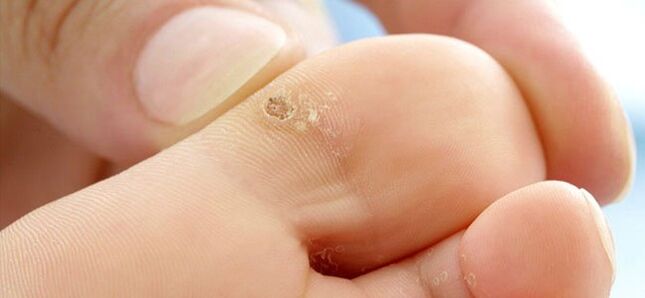
It is necessary to begin the use of keratolytic in the early stages of neoplasm formation. In this case, it is possible to avoid recurrence. If the spine has grown deeply, you should use a hardware treatment method that gives the desired result and guarantees the absence of recurrence.
If plantar warts do not cause much concern, you can overcome them with folk remedies - a solution of acetic acid, lemon juice, garlic tincture. An acidic environment has a detrimental effect on the virus, stopping its reproduction and preventing its growth.
Surgery
Classical surgery with the use of a scalpel is rarely performed. Such an intervention can only be done when removing large growths, which cannot be eliminated by other methods. Surgery is performed using local anesthesia. The surgeon removes the wart and cleans the wound thoroughly, trying to remove the deep root completely. Disadvantages of this method include pain, risk of wound infection and the development of subsequent complications, a long recovery period, in which a person is limited in movement.
It is best to remove plantar warts using less traumatic and safe hardware techniques. Referral to the procedure is given by the doctor after an initial examination and identification of possible contraindications. The main treatment options are:
Electrocoagulation
The essence of this method is to clean the accumulating tissue with a high -frequency electric current. The procedure is performed with the use of local anesthesia, as it is accompanied by a painful sensation. This option is only suitable for removing medium -sized spines, with superficial proliferation to the depths of the dermis. If large formations are auterized, the risk of scar formation and recurrence is not excluded.
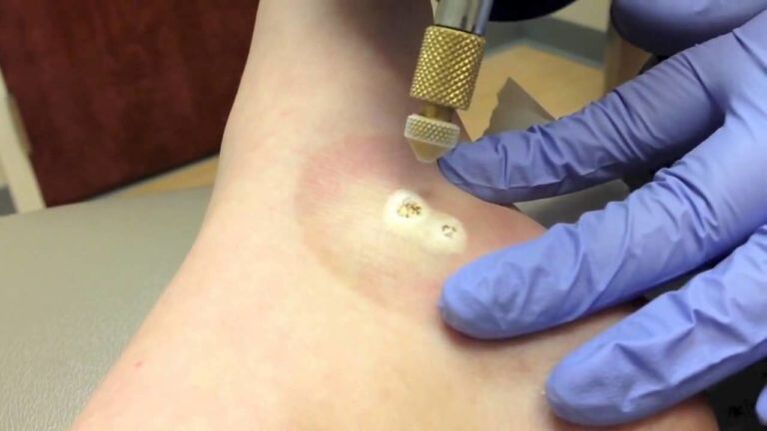
The recovery period after electrocoagulation requires a long time, requires treatment of the wound with an antiseptic solution, excluding infections. During the recovery process, the patient is limited in movement, because the load on the leg causes a painful sensation.
Cryodestruction
This is one of the most popular and affordable methods of treating plantar warts. The procedure only takes a few minutes and involves treatment of the neoplasm with liquid nitrogen. Ultra low temperatures give an immediate freezing effect. Frozen fluid breaks down pathological neoplasm cells from the inside - as a result, the warts undergo necrosis and die within 10 days.
During the session, the doctor presses the applicator with coolant onto the neoplasm for a few seconds, protecting the surrounding healthy tissue. The effectiveness of the procedure is evidenced by the whitening of the skin in the treatment area. Soon, blisters form at the site of the wart, which cannot be touched or pricked. It is recommended to cover it with plaster to prevent injury. After a few days, the blisters will dry out and a crust will form in its place. After the fall, healthy and fresh skin will remain in the wart area.
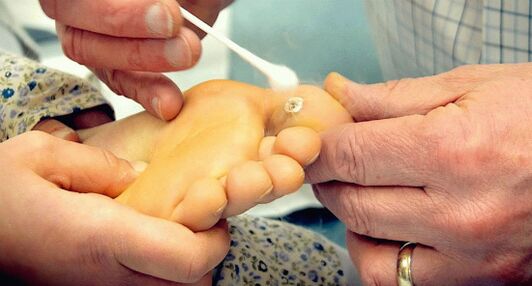
This procedure can only be performed by an experienced technician. Excessive exposure time causes damage to deep tissues, followed by scar formation, and too superficial exposure does not destroy the root of the wart, which will lead to the emergence of new growth.
Laser removal
Modern procedures give the best aesthetic results, allow you to control the depth of exposure, eliminating the risk of complications. The laser beam evaporates layer by layer of wart tissue, simultaneously freezing the blood vessels and disinfecting the operating area. Such an effect eliminates the risk of bleeding, infection, guarantees the absence of recurrence, as it prevents the spread of viral particles. Different types of lasers are used to get rid of warts - erbium, acid or pulsed.
The laser procedure is safe, effective and painless, and does not require a long recovery period. At the site of the removed wart, a small wound is still present, which is covered with a plaster. After the procedure, the patient is able to return home and lead a normal life. The recovery period is very short - complete healing only takes a few days.
Disposal with a radio knife
The essence of the latest technique is the use of radio waves, which allows you to get rid of plantar warts in the fastest and safest way. Strong heat radiation burns the buildup without direct contact with the surrounding tissue. The fluid in the neoplasm cells evaporates momentarily, which causes the destruction of the wart. At the same time, healthy skin is not damaged; during the procedure, the doctor adjusts the depth and duration of exposure. At the same time, high -frequency radio waves disinfect the surgical field and clean the blood vessels, which eliminates the risk of bleeding.
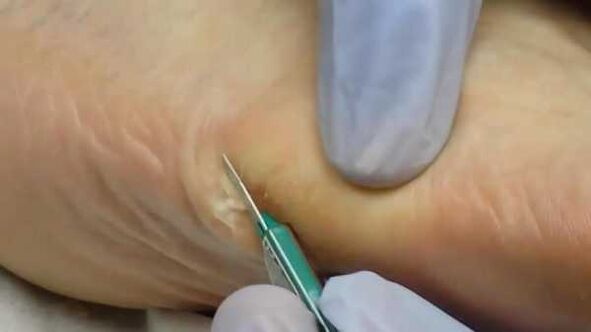
What method to deal with plantar warts, the patient decides together with the attending physician. Prior to the appointment of the procedure, the dermatologist is aware of the possibility of contraindications.
List of restrictions on the use of any hardware method:
- inflammatory processes on the skin in the treatment area;
- diabetes;
- infectious, respiratory diseases (ARVI, ARI);
- high blood pressure;
- increased herpesvirus infection;
- pregnancy.
The question of the use of the apparatus method in connection with the child is discussed with the doctor. Some procedures have age restrictions, so you should know in advance all the nuances of the proposed method and make sure that there is no danger to the health of the baby.























